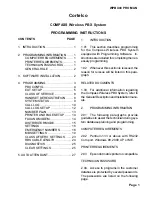
Chapter 3. Administrative Basics
70
• Each job or configured instance of a job module is identified by the name specified when the job
was created.
• There can be as many instances of an implementation as desired; each instance must have a
unique name. To do this, copy all of the parameters belonging to the module used to create the
instance. Change the name of each of these parameters to the new name for this instance, and
then change the values of all the parameters as appropriate.
3.6.4. Duplicating Configuration from One Instance to Another
When deploying a large number of Certificate System instances that are identical and all these
instances should have the same configuration, it is possible to configure one of the instances and
then replace the configuration files of the other instances with the one that contains the required
configuration.
NOTE
Be careful when replacing configuration of one instance with another. The configuration
file for the original instance contains instance-specific parameters. If the new instance's
configuration file is directly replaced with that of the first instance, the new instance will fail
to start properly if the instance specific parameters are not adjusted to those required by
the new instance.
The recommended way to create duplicate instances is to clone the instances when the
subsystem instance is configured. For more information on cloning, see
Chapter 20,
Configuring the Certificate System for High Availability
.
3.6.5. Other File Locations
Certificate System servers consist of subsystems and instances. Server subsystems are contained
in non-relocatable RPMs analogous to shared libraries, Java
™
archive files, binaries, and templates
which must be stored in a fixed location, while server instances analogous to relocatable, user-specific
default and customized forms and data, which can be stored anywhere on a system.
Since Certificate System server RPMs are non-relocatable, the subsystem file locations listed in
Table 3.1, “Server File Locations”
are fixed.
Directory Location
Contents
/usr/bin
pkicreate
and
pkiremove
instance
configuration scripts and tools (Java
™
, native,
and security) shared by the CA, RA, DRM,
OCSP, and TKS subsystems.
/usr/lib
Libraries shared by the CA, RA, DRM, OCSP,
and TKS subsystems.
For 32-bit Red Hat
Enterprise Linux AS and ES i386 machines only.
/usr/lib/dirsec
Security libraries shared by the CA, RA, DRM,
OCSP, and TKS subsystems.
For 32-bit Red Hat
Enterprise Linux AS and ES i386 machines only.
/usr/lib/java
JNI Java
™
archive files shared by the CA, RA,
DRM, OCSP, and TKS subsystems.
For 32-
Summary of Contents for CERTIFICATE SYSTEM 7.3 - ADMINISTRATION
Page 15: ...xv Index 525 ...
Page 16: ...xvi ...
Page 38: ...Chapter 1 Overview 16 Figure 1 4 Certificate System Architecture ...
Page 82: ...Chapter 2 Installation and Configuration 60 rpm ev rhpki manage ...
Page 154: ...132 ...
Page 194: ...172 ...
Page 238: ...216 ...
Page 244: ...222 ...
Page 246: ...224 ...
Page 286: ...264 ...
Page 292: ...270 ...
Page 318: ...Chapter 13 Certificate Profiles 296 Parameter IssuerType_n IssuerName_n ...
Page 321: ...Freshest CRL Extension Default 299 Parameter PointName_n PointIssuerName_n ...
Page 398: ...376 ...
Page 412: ...390 ...
Page 472: ...450 ...
Page 506: ...484 ...
Page 528: ...506 ...
Page 546: ...524 ...
















































